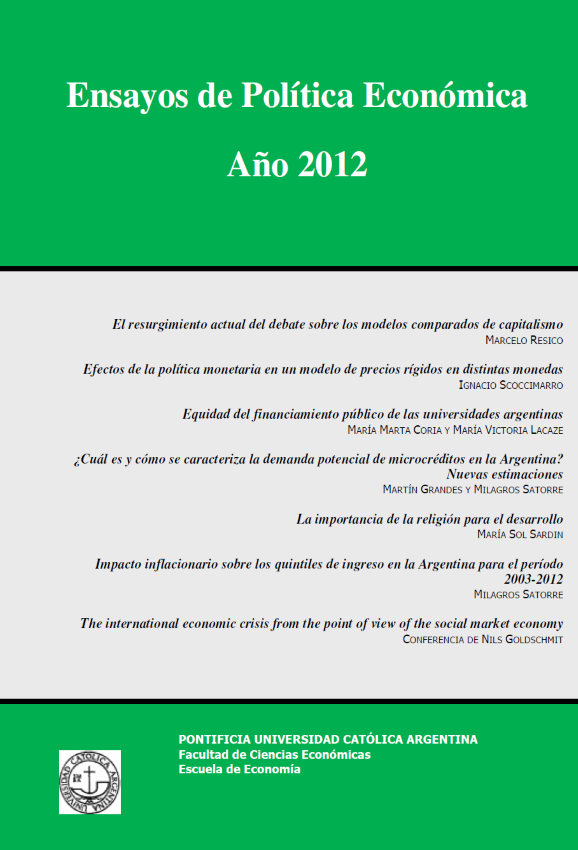Effects of monetary policy on a rigid price model in different currencies
Keywords:
price setting currency, exchange rate, monetary policy, sticky pricesAbstract
In a two country dynamic model with sticky prices, this paper analyses the monetary policy transmission when firms set their prices in different currencies. Following Betts and Devereux (2000) we include an assumption that allows firms to set a unique price for local and foreign market in the currency of the importer. Some firms price to market and some firms set their prices in their own or their neighbor’s currency. The presence of sticky prices in the currency of the importer increases the volatility of exchange rate and reduces the positive effect that monetary policy has on consumption and real interest rates. In the absence of pricing to market, the bigger the number of firms that set their prices in the importer´s currency, the
bigger the effect that a monetary shock, in the foreign country, has on its welfare and on its neighbor´s. However, the positive effect is lower, in both countries, when the shock occurs in the local country.
Downloads
References
Bacchetta, P. and Van Wincoop, E. (2003). “Why do consumer prices react less than import prices to exchange rates?”, Journal of the European Economic Assosiation, MIT Press, 1/(2-3), pp. 662-670, 04/05.
Bacchetta, P. and Van Wincoop, E. (2005). “A theory of currency denomination of international trade”, Journal of International Economics, 67/2, 295-319.
Baron, D. P. (1976). “Fluctuating exchange rates and the pricing of exports”, Economic Inquiry, vol. 16, pp. 425-438.
Betts, C. and Devereux, M. B. (1996). “The exchange rate in a model of pricing to market”, European Economic Review, vol. 40, pp. 1007-1021.
Betts, C. and Devereux, M. B. (2000). “Exchange rate dynamics in a model of pricing to market”, Journal of International Economics, vol. 50, pp. 215-244.
Corsetti, G. and Dedola, L. (2005). “A Macroeconomic Model of International Price Discrimination”, Journal of International Economics, vol. 67, nº 1, pp. 129-155.
Corsetti, G. and Presenti, P. (2005). “International Dimensions of Optimal Monetary Policy”, Journal of Monetary Economics, vol. 52, nº 2, pp. 281-305.
Devereux, M. B. and Engel, C. (2001). “Endogenous Currency of Price Setting in a Dynamic Open Economy Model”, NBER, working paper nº 8559.
Dominguez, K. M. E. and Tesar, L. L. (2001). “Trade and Exposure”, American Economic Review, vol. 91, nº 2, pp. 367-370.
Donnenfeld, S. and Zilcha, I. (1991). “Pricing of Exports and Exchange Rate Uncertainty”, International Economic Review, vol. 32, nº 4, pp. 1009-1022.
Engel, C. (2006). “Equivalent results for optimal pass-through, optimal indexing to exchange rates and optimal choice of currency for export pricing”, Journal of the European Economic Association, MIT Press, 4/6, pp. 1249-1260.
Friberg, R. (1996). “On the Role of Pricing Exports in a Third Currency”, Stockholm School of Economics, working paper nº 128.
Friberg, R. (1997). “Should the Core fear the Outs? Price setting practices and international monetary transmission”, Stockholm School of Economics, working paper nº 203.
Friberg, R. (1998). “In Which Currency should Exporters set their Prices”, Journal of International Economics, vol. 45, pp. 59-76.
Giovannini A. (1988). “Exchange Rates and Traded Goods Prices”, Journal of International Economics, vol. 24, pp. 45-68.
Goldberg, L. S. and Tille, C. (2005). “Vehicle Currency use in
International Trade”, Federal Reserve Bank of New York, staff report nº 200.
Mark, N. C. (2000): “International Macroeconomics and Finance: Theory and Empirical Methods”, Forthcoming, Blackwell Publishers.
Obsfeld, M. and Rogoff, K. (1996). “Foundations of International Macroeconomics”, The MIT Press.
Obsfeld, M. and Rogoff, K. (1995). “Exchange Rate Dynamics Redux”, Journal of Political Economy, vol. 102, pp. 624-660.
Downloads
Published
How to Cite
Issue
Section
License







 Ensayos de Política Económica
Ensayos de Política Económica